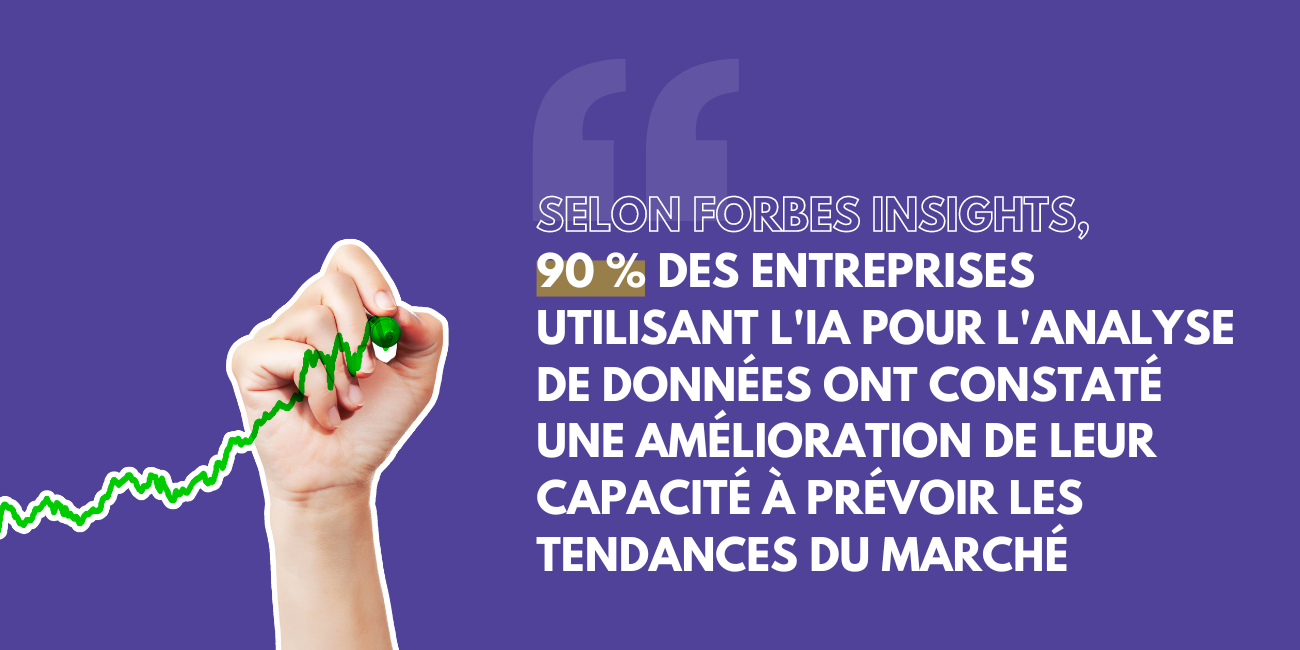The digital age has brought with it an explosion of data. In this context, analysing this information has become essential for making informed decisions, optimising performance and better understanding consumer behaviour.
But this wealth of data can sometimes prove a real challenge when it comes to extracting meaningful information manually. That’s where Artificial Intelligence (AI) comes in.

1. AI: A major asset for data analysis
Rapid processing of massive data
As you will have gathered, one of the main challenges facing businesses is processing large quantities of data in real time. Unlike humans, AI excels at this task, using sophisticated algorithms to sort, filter and analyse massive datasets in seconds.
Online advertising platforms such as Meta and TikTok, which use AI to rapidly analyse billions of data points on user preferences and display targeted ads in real time, are a perfect example of this technology! Google Ads also uses AI to generate targeted ads based on assets such as titles, descriptions and images. This data-driven approach makes it possible to create dynamic, personalised ads that adapt to user behaviour in real time. Unlike manually designed ads, those generated by AI offer greater relevance, increasing click-through rates (CTR) and conversion rates. By relying on AI, these platforms guarantee more effective advertising campaigns and an optimised user experience.
A new tool: ChatSpot
ChatSpot, HubSpot’s latest innovation, could well revolutionise the digital sector. This tool uses AI to provide intelligent virtual assistance to marketing and digital teams. Thanks to its advanced natural language processing, the tool can understand and answer customer questions in real time, improving customer service efficiency and boosting user engagement.
What’s the best thing about this tool? ChatSpot goes beyond predefined answers and uses machine learning to continually adapt to new questions and changes in user behaviour. It is able to provide personalised recommendations based on past interactions with the customer, enabling relevant products or services to be offered at the right time.
Detecting patterns and hidden trends
Artificial intelligence and big data, two interdependent technologies, play a crucial role in detecting patterns and trends hidden within data. Indeed, artificial intelligence, fed by an immense quantity of data, finds its strength in the in-depth analysis of the information it is provided with. Big Data, with its ability to store, manage and process huge volumes of data, provides artificial intelligence with the resources it needs to develop its knowledge and improve its algorithms. Thanks to this synergy, AI can identify patterns and trends that would be difficult, if not impossible, to discern manually.
At the heart of this collaboration is Machine Learning, a well-known terminology for the process by which robots use data to learn and adjust automatically. Thanks to AI and Big Data, Machine Learning enables systems to detect links between data and uncover hidden information that often escapes the human eye.
As a result, data analysis becomes more reliable and relevant, leading to more accurate and informed decisions. What’s more, this approach makes it possible to take advantage of new commercial opportunities by identifying emerging trends or hidden customer behaviours.
2. AI techniques used in data analysis
Machine Learning
Machine learning is one of the key AI techniques used in data analysis. It falls into two main categories: supervised learning and unsupervised learning.
- In supervised learning, AI uses labelled data sets to learn how to make predictions or decisions. For example, in digital marketing, AI can be trained to predict user behaviour based on their purchase history and other demographic data. This technique can be useful, for example, for an e-commerce business that wants to improve the personalisation of its offers for its customers.
- Unsupervised learning, meanwhile, enables AI to analyse data without prior labels, in order to find similar structures and groups within the dataset. This can be useful for segmenting customers according to their interests or preferences, enabling further personalisation.
Machine learning is present in most of the AI we use. Machine learning includes deep learning, which uses neural networks.
Artificial neural networks (deep learning)
Artificial neural networks are AI models inspired by the workings of the human brain. These networks are capable of learning complex models and performing sophisticated tasks such as image recognition, machine translation and time series prediction. In data analysis, neural networks are often used for classification, regression and data generation.
Natural Language Processing (NLP)
Natural language processing is an essential branch of AI, enabling machines to understand and communicate fluidly with human beings. It is widely used in data analysis, where it plays a key role in extracting meaningful information from unstructured text such as customer comments and product reviews. By harnessing NLP, businesses can quickly analyse customer sentiment and identify emerging issues, making a significant contribution to improving their customer service and enhancing their online reputation.
At the same time, AI has become indispensable in the field of social listening, where it responds to the need to analyse huge volumes of data generated by social media. Customer comments, product reviews and social media posts provide a wealth of information about consumer preferences and market trends. With NLP, companies can quickly extract meaningful insights from this unstructured text. This capability enables them to monitor customer sentiment in real time, detect emerging issues and take proactive steps to resolve them. AI-powered social listening also enables businesses to identify opportunities for growth, adjust their marketing strategies and strengthen their online presence and reputation.
3. Concrete examples of the use of AI in data analysis
Predictive analysis for optimising advertising campaigns
Online advertising campaigns can be costly and it is crucial to invest in ads that generate a high return on investment (ROI). AI can be used to analyse historical advertising campaign data, as well as user demographic and behavioural data, to predict which ads will have the most impact on which audience. This predictive analysis enables advertisers to more accurately target the audience segments most likely to convert, maximising the effectiveness of their advertising campaigns.
Customised content and recommendations
In e-commerce and online content, personalisation is key to engaging users and building loyalty. AI is used to analyse users’ browsing behaviour, previous purchases and interactions on the site, in order to offer personalised recommendations. For example, a music streaming site can use AI to recommend songs and artists based on each user’s musical preferences, thereby increasing the time spent on the platform and encouraging the discovery of new content.
4. Conclusion
AI has radically transformed data analysis, enabling businesses to make more informed decisions, optimise performance and improve customer relationships. Using techniques such as machine learning, artificial neural networks and natural language processing, it is now possible to optimise advertising campaigns, personalise content and recommendations, and improve overall decision-making.
However, as with any powerful technology, it is essential to use AI responsibly and ethically. It’s important to be aware of potential biases in the data and to ensure that you use diverse data sets to obtain balanced results. By integrating human skills and expertise into the process, companies can better interpret AI results and ensure more informed decisions.




